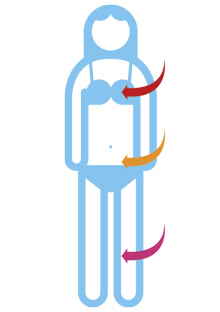Cysts: What Are They Anyway?

Illustration: Jez Burrows
These fluid-filled sacs can show up in any part of your body—coming and going as they please—but most are just harmless lumps. We asked three specialists what every woman should know.
Breast Cysts
What Causes Them: Blocked milk ducts. "Glands in your breasts are always secreting fluid, which can contain particles that obstruct tiny ducts. If that happens, a duct fills with fluid, becoming a simple cyst," says breast cancer surgeon S. Eva Singletary, MD, a professor at the University of Texas M.D. Anderson Cancer Center in Houston.
How to Get Rid of Them: Just wait. It takes up to a year for fluid in a cyst to disperse. In the meantime, some research suggests that cutting back on caffeine or taking evening primrose oil capsules may relieve cyst-related breast pain, Singletary says. If a cyst is extremely uncomfortable, ask your doctor about draining the fluid with needle aspiration.
Why They Come Back: "We think it has to do with hormone levels in breast tissue and also with genetics—some women simply inherit a tendency toward lumpy, bumpy breasts," Singletary says. Hang in there. Cysts are most common in younger women; you'll have fewer as you approach menopause because hormone levels drop.
Should I Worry?: It's crucial to have any new lump in your breast checked by your doctor. But once you get the all clear, you can relax—cysts don't raise breast cancer risk. "A cyst feels like a grape, and sometimes you can move it around a little under the skin, while a lump that may be cancer feels rock-hard and usually can't be moved," Singletary says.
Ovarian Cysts
What Causes Them: Ovulation. The most common ovarian cysts (called functional) come in two types: typically follicular cysts, which contain an unreleased egg; and more troublesome corpus luteum cysts—fluid-filled sacs that form after an ovary releases an egg. These sacs can grow larger than a baseball and trigger piercing pain.
How to Get Rid of Them: Do nothing. Most functional cysts clear up in eight to 12 weeks. "Opting for surgery could decrease your fertility," says Barbara Goff, MD, professor of gynecologic oncology at the University of Washington. "If you must have surgery—because, say, a cyst is bleeding—ask if you can have just the cyst removed and not your ovary."
Why They Come Back: "Women with endometriosis tend to get recurrent cysts, but otherwise, it's just random bad luck," says Goff. Research is still trying to determine what makes some women prone to functional cysts.
Should I Worry?: No, because functional cysts don't raise cancer risk. If your doctor feels a bump on your ovary, she should check it with ultrasound and—if you're postmenopausal, or premenopausal with an above-average risk for ovarian cancer—consider giving you a CA-125 blood test for a protein found in cancer cells.



